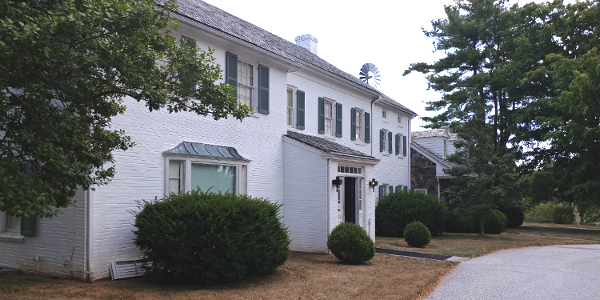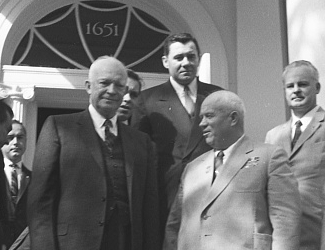
Image above: Park headquarters at Eisenhower National Historic Site.
Spotlight on Lesser Known History
Eisenhower Farm, Pennsylvania
America's Best History Spotlight
On this page we're going to Spotlight the lesser known historic sites and attractions that dot the history landscape across the USA and are worth a visit if you're in their area. And while they may be lesser known, some are very unique, and will be that rare find. You'll be, at times, on the ground floor, or maybe even know something others don't. It'll be fun. Visit them.

Eisenhower Farm, Pennsylvania
It was the only home President Dwight David Eisenhower, the general commanding Allied troops during World War II, would ever own. It was a farm in a location he knew well, Gettysburg, Pennsylvania, and located directly next to the Gettysburg National Military Park of that 1863 battle in Civil War history that turned the tide of that war. For most, the fact that another National Historic Site is located in Gettysburg is not that well known, and many don't take the time to visit it while there. But the peaceful farm next door is a national treat that tells the story of another President who held diplomatic meetings with a Soviet leader there, and retired there to raise cattle after his two terms were done. Photo above: One of the many barns on the Eisenhower farm property.
Sponsor this page. Your banner or text ad can fill the space above.
Click here to Sponsor the page and how to reserve your ad.
Info, What's There Now, History Nearby

Eisenhower National Historic Site, Pennsylvania
Although President Eisenhower had not been born in Pennsylvania, but Denison, Texas, and lived most of his youth in Kansas, he had known the Gettysburg locale well since his days as a military instructor in the town during World War I. At that time, he lived in a house in town, but plied the streets and fields surrounding the battlefield during his exercises with the troops that he commanded. Due to his military career, Eisenhower and his wife, Mamie, were always on the move and had never settled down to own a property of their own.
With his tenure in the Army thought complete, the Eisenhowers searched for a property to retire to, returning to Gettysburg. They bought the farm in 1950, but did not use it much in the first several years as Eisenhower returned to duty as the head of NATO, then ran for President for the first time in 1952.
Image above: View of the home at Eisenhower National Historic Site. Below: Photo of the kickoff event of Eisenhower's 1956 presidential campaign held at the farm on September 12, 1956, Thomas J. Halloran. Courtesy Library of Congress.

Where Is It
Eisenhower National Historic Site is located directly next to Gettysburg National Military Park off Emmitsburg Road and Millerstown Road. Most years access to the property is on a bus tour from the Gettysburg NMP Visitor Center, however, there are some days when you may drive directly to the park, as is the current, 2020, situation. Check at the Gettysburg Visitor Center for the access point on the day you wish to visit.
Minute Walk in History
Take a walk with us around the Eisenhower National Historic site, his only home and cattle farm, while President Eisenhower gives his last address to the citizens of the USA upon his retirement from office. Then when you visit Gettysburg, take the ride or the bus over from the Gettysburg NMP Visitor Center, and witness history, 1950's and 1960's style.
What is There Now
Today, Eisenhower National Historic Site is located on six hundred and ninety acres with the historic Eisenhower home, various barns, pastures, cottages, a putting green, and other historic structures. There are wayside markers and exhibits.
A cell phone tour is available for the points of interest on the property. If you are there on a day when house and property tours are available, the park rangers on the property do a fantastic job of telling you not only the story of the farm, but of Eisenhower and his life. A World War II weekend is held on the property most Septembers. There are Eisenhower in Gettysburg tours in town some nights of the summer.
When Open and How Much
The site is open year round, except for major holidays. When access to the site is provided through the shuttle bus service from the Gettysburg National Military Park Visitor Center, there is a fee for transportation ($9 adults, $5 children 6-12, Free under 6), which usually includes a site tour. However, with a recently expanded on-site parking lot, you can visit the site directly, and it is free to visit.
Fees subject to change.
Websites
Eisenhower National Historic Site
History Nearby
Of course, the obvious and most important historic site is Gettysburg National Military Park right next door. Eisenhower is a great adjunct to visit while visiting the Civil War battlefield, but there's so much to do in the surrounding area that your trip should take several days. A variety of museums include Civil War Tails, the Gettysburg Heritage Center, and the Seminary Museum. Not too far south of Gettysburg, there's Catoctin Mountain Park and another Civil War gem, Antietam. For those that like a little amusement in their trips, Hersheypark is located only forty-five minutes away.
Buy Chronology

Great Book for the History Fan with Fifty Short Essays Telling the Story of American History.
Photos, History, and More Spotlights

Eisenhower Prior History at Gettysburg
The first encounter that Dwight Eisenhower had with the town of Gettysburg occured when he was a cadet at West Point. During a senior class trip in the spring of 1915, Eisenhower began a fascination with the battlefield. When World War I broke out, Captain Eisenhower would return, now commanding Camp Colt on the battlefield in 1918, training troops for the new U.S. Tank Corps on the fields of Pickett's Charge. The camp included one hundred and seventy-six acres of the Codori farm, ten acres of the Smith farm, and six acres of the Bryan House property. There were ten thousand six hundred officers and men under his command at Camp Colt. The Eisenhower's would live in a house downtown near Gettysburg College. That home still exists.
One hundred and fifty men from Camp Colt died in the 1918 Spanish flu epidemic.
After World War II and during his stint as President of Columbia University, Eisenhower and his wife Mamie returned to Gettysburg to search for a home. In 1950, they bought the Redding farm, a one hundred and eighty-nine acre tract west of the battlefield.
Image above: The Eisenhower cottage at the farm. This is the structure where many of his guests would stay. It is located not far from the front door of the home.

Eisenhower Detente at Gettysburg
Nikita Khrushchev had risen to power in Soviet Russia early in the first term of President Eisenhower. By the end of the decade, both the United States and the Soviet Union had decided to coexist, even though the United States disagreed with most of the policies of the empire toward their neighbors. In 1959, the Eisenhower administration decided that the first visit of a Soviet premier to the United States should occur.
For eleven days in 1959, Khrushchev toured the United States, then met with President Eisenhower at Camp David, eighteen miles south of Gettysburg in Catoctin Mountain Park. When the summit of nuclear disarmament came to an impasse, Eisenhower decided to invite Kruschchev to his farm. On September 26, 1959, they walked the farm, saw the Eisenhower cattle operation, including prize bull Ankonian 3551, and visited with his granchildren. The meeting was pleasant, but did not lead to an agreement.
Photo above: President Eisenhower and Soviet Premier Nikita Khrushchev on the steps of Blair House, one day after their meeting on the Gettysburg farm, September 27, 1959, John T. Bledsoe. Courtesy Library of Congress.

Eisenhower and his Farm
By 1955, President Eisenhower had recontructed the home of the property and spent many weekends there. He played golf at the Gettysburg Country Club and raised Angus cattle. It was not only Khrushchev who visited, many other dignitaries were brought to the farm for informal detente.
In 1961, after his second term as President was over, the Eisenhower's retired full time to the farm. Dwight maintained an office at Gettysburg College, wrote his memoirs, continued his penchant for oil painting, and ran the farm. In 1967, the couple donated the farm to the National Park Service. In 1980, the site was opened to the public.
Photo above: The putting green at Eisenhower farm.

T-Shirts and Gifts from the official souvenirs of Americasbesthistory.com.

About
America's Best History where we take a look at the timeline of American History and the historic sites and national parks that hold that history within their lands.
Photos courtesy of the Library of Congress, National Archives, National Park Service, americasbesthistory.com and its licensors.
- Contact Us
- About
- © 2025 Americasbesthistory.com.
Template by w3layouts.

